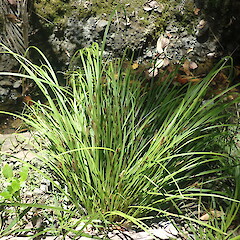Carex ochrosaccus
Common name
forest sedge
Synonyms
Carex dissita Boott var ochrosaccus C.B.Clarke ex Cheeseman
Family
Cyperaceae
Flora category
Vascular – Native
Endemic taxon
Yes
Endemic genus
No
Endemic family
No
Structural class
Sedges
NVS code
The National Vegetation Survey (NVS) Databank is a physical archive and electronic databank containing records of over 94,000 vegetation survey plots - including data from over 19,000 permanent plots. NVS maintains a standard set of species code abbreviations that correspond to standard scientific plant names from the Ngä Tipu o Aotearoa - New Zealand Plants database.
CAROCH
Current conservation status
The conservation status of all known New Zealand vascular plant taxa at the rank of species and below were reassessed in 2017 using the New Zealand Threat Classification System (NZTCS) – more information about this can be found on the NZTCS website. This report includes a statistical summary and brief notes on changes since 2012 and replaces all previous NZTCS lists for vascular plants.
Please note, threat classifications are often suggested by authors when publications fall between NZTCS assessment periods – an interim threat classification status has not been assessed by the NZTCS panel.
- Conservation status of New Zealand indigenous vascular plants, 2017 . 2018. Peter J. de Lange, Jeremy R. Rolfe, John W. Barkla, Shannel P. Courtney, Paul D. Champion, Leon R. Perrie, Sarah M. Beadel, Kerry A. Ford, Ilse Breitwieser, Ines Schönberger, Rowan Hindmarsh-Walls, Peter B. Heenan and Kate Ladley. Department of Conservation. Source: NZTCS and licensed by DOC for reuse under the Creative Commons Attribution 4.0 International licence.
2017 | Not Threatened
Previous conservation statuses
2012 | Not Threatened
2009 | Not Threatened
2004 | Not Threatened
Distribution
Endemic. New Zealand: North Island, mostly from Whangarei and Dargaville South to the Bay of Plenty and Mokau River. South of there is a sparsely distributed species, ranging about as far south as the Manawatu Gorge.
Habitat
Coastal to lowland usually in damp situations within alluvial forest but also along stream banks and within coastal seepages. Sometimes forming extensive sedgelands within willow carr.
Wetland plant indicator status rating
Information derived from the revised national wetland plant list prepared to assist councils in delineating and monitoring wetlands (Clarkson et al., 2021 Manaaki Whenua – Landcare Research Contract Report LC3975 for Hawke’s Bay Regional Council). The national plant list categorises plants by the extent to which they are found in wetlands and not ‘drylands’. The indicator status ratings are OBL (obligate wetland), FACW (facultative wetland), FAC (facultative), FACU (facultative upland), and UPL (obligate upland). If you have suggestions for the Wetland Indicator Status Rating, please contact: [Enable JavaScript to view protected content]
FAC: Facultative
Commonly occurs as either a hydrophyte or non-hydrophyte (non-wetlands).
Detailed description
Densely tufted and robust sedge, 0.45–1 m tall. Culms 1.0–1.5 mm diameter, trigonous, smooth; basal sheaths red-brown, yellow-brown or grey-brown. Leaves > culms, 3–4 mm wide, double-folded, light green, glossy, margins slightly scabrid. Spikes 5–7; terminal 1–(2) spikes male, occasionally mixed with female flowers; remaining spikes female, 15–60 × 5–7 mm, shortly pedunculate, erect, distant, the lower often compound. Glumes (excluding awn) < utricles, ovate, acute or emarginate, pale cream flecked with small brown striae, membranous, midrib green, produced to a very fine scabrid awn c. ½ length of glume. Utricles 2.5–3.0 × c. 1 mm, ellipsoid, turgid, light yellow-brown, occasionally darker brown, especially towards the top, distinctly nerved, margins near the top finely scabrid, gradually tapering to the narrow bifid beak, c. 0.5 mm. long, orifice scabrid. Stigmas 3. Nut c. 1.5 mm. long, trigonous, light brown.
Similar taxa
Carex ochrosaccus is rather similar to C. dissita and C. lambertiana species from which it is easily distinguished by the light cream glumes and distinctly nerved utricles.
Flowering
October–January
Fruiting
Throughout the year.
Life cycle
Nuts surrounded by inflated utricles are dispersed by granivory and wind (Thorsen et al., 2009).
Propagation technique
Easily grown from fresh seed and by the division of established plants. Excellent for a permanently damp situation in a shaded site but will tolerate full sun and dry conditions once established.
Etymology
carex: Latin name for a species of sedge, now applied to the whole group.
Attribution
Fact Sheet prepared by P.J. de Lange (10 August 2006). Description adapted from Moore and Edgar (1970)
References and further reading
Moore LB, Edgar E. 1970. Flora of New Zealand, Volume II. Indigenous Tracheophyta: Monocotyledones except Gramineae. Government Printer, Wellington, NZ. 354 p.
Thorsen MJ, Dickinson KJM, Seddon PJ. 2009. Seed dispersal systems in the New Zealand flora. Perspectives in Plant Ecology, Evolution and Systematics 11: 285–309.
NZPCN Fact Sheet citation
Please cite as: de Lange, P.J. (Year at time of access): Carex ochrosaccus Fact Sheet (content continuously updated). New Zealand Plant Conservation Network. https://www.nzpcn.org.nz/flora/species/carex-ochrosaccus/ (Date website was queried)









